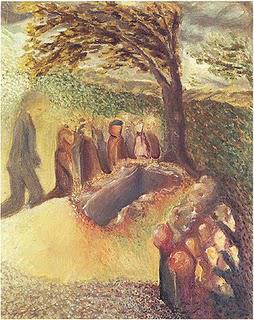Chamber arrangement of Das Lied von der Erde performed for work's centennial.

The Burial of Gustav Mahler.
Painting by Arnold Schoenberg.
© 1911 The Arnold Schoenberg Foundation.
On Thursday night, the St. Luke's Chamber Ensemble performed Gustav Mahler's Das Lied von der Erde in a stripped-down verson for 14 musicians and two singers. This orchestration, created by Mahler's contemporary Arnold Schoenberg, brought the voices of tenor Paul Groves and Jennifer Johnson Cano to the fore. The result: an unexpected intimacy in Mahler's music.
Das Lied von der Erde ("The Song of the Earth") was originally planned as Mahler's Ninth Symphony. It marks the beginning of Mahler's final years, a race against time and his own, defective heart.Its text is drawn from The Chinese Flute, a German translation of seven Chinese poems. The songs offer poignant, sometimes bitter descriptions of nature, everyday life, and the occasional drinking binge.
Arnold Schoenberg began, but did not complete, his arrangement of Das Lied in 1920, intending the work for a series exploring contemporary music in Vienna. (It was finished in 1980 by composer Ranier Riehn.) The spare arrangement (five string players, three winds, horn, piano, harmonium, glockenspiel, and percussion) emphasizes the connection between the late music of Mahler and the works of Schoenberg were made very clear by the reduced orchestra.
A chuckling, splashing horn-call opens Das Trinklied von der Jammer der Erde. ("The Drinking-song of Earth's Sorrow") The small orchestra revealed fresh details in the score, including quotations from earlier Mahler works. Paul Groves soared over the orchestra with a strong heldentenor delivery, rising blissfully through each verse. With remarkable control, he subdued his instrument to deliver the grim refrain: "Dark is love, dark is death!"
He was ably supported by the St. Luke's Chamber Ensemble under the baton of George Manahan. The veteran conductor attained clarity from his little band, working hard to correct the balance problems caused in the bright-sounding hall. The second movement, Der Einsame im Herbst ("The Lonely One in Autumn") brought Ms. Cano's fervent mezzo to the fore. She sang with sweet, pliant tone, handling the long vocal phrases with power and ease
Two little movements (Von der Jugend ("Of Youth") and Von der Schönheidt ("Of Beauty") followed, depicting folksy images Chinese art, accompanied by Mahler's development of the traditional Asian pentatonic scale. Each movement was delivered with warmth and humor by the vocal soloists. Mr. Groves surged to the fore again for Der Trunkene im Frühling ("The Drunkard in Springtime"), navigating expertly through the tricky "off" rhythms that indicate the singer's inebriated state.
Mr. Manahan achieved stunning effects in the final Der Abschied ("The Farewell") making his chamber ensemble breathe and thunder like a huge Mahlerian band. This extended movement, lasting just over half an hour, features the final two songs from The Chinese Flute bridged together with a complex, almost atonal central passage.
Ms. Cano displayed remarkable vocal stamina, lasting through to the final passages of this marathon movement. She phrased the final, repeated" Ewig, ewig" unwinding the notes as if they were the white wrappings of a funeral shroud. The work ended on somber, trascendant chords, resolving the questions posed by the composer even as it lulled the audience to a state of bliss.

